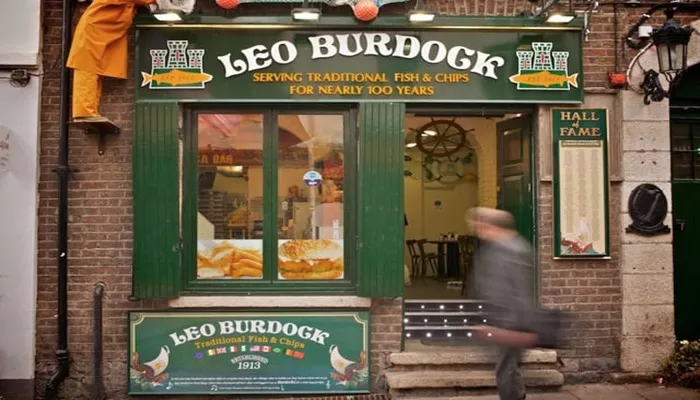Leo Burdock, often referred to simply as “Burdocks,” is a legendary fish and chip shop located in Dublin, Ireland. Established in 1913 by Bella and Patrick Burdock, the shop has become an iconic symbol of Dublin’s culinary landscape. The original location is situated on Werburgh Street, near Christ Church Cathedral, and it is recognized as Dublin’s oldest chipper. Over the years, Leo Burdock has garnered a reputation for its high-quality fish and chips, attracting both locals and international visitors, including numerous celebrities.
The story of Leo Burdock is not just about food; it reflects the resilience and evolution of a family business that has withstood historical challenges such as wars and economic downturns. From its humble beginnings to its current status as a cherished institution, Leo Burdock has maintained a commitment to quality and tradition. The menu primarily features cod, although other fish varieties are available depending on the day’s catch. The preparation methods have evolved, but the essence of serving generous portions of freshly cooked fish and chips remains unchanged.
Leo Burdock Franchise Cost
The cost of opening a Leo Burdock franchise is structured to provide potential franchisees with a clear understanding of the financial commitment involved. Here are the key details regarding the franchise cost:
Initial Investment
Fit-Out Costs: Franchisees can expect to invest approximately €150,000 for the fit-out of a Leo Burdock location. This amount covers the expenses related to constructing and equipping the restaurant according to the brand’s specifications.
Franchise Fee: While specific figures for the franchise fee are not publicly detailed, it is typically required to be paid in advance of signing the franchise agreement. This fee includes training and ongoing support from Leo Burdock.
Operational Costs: In addition to the initial investment, franchisees must budget for ongoing operational costs, which include staffing, inventory (with food supplies purchased weekly from Leo Burdock), utilities, and maintenance.
Franchise Royalty
Franchisees are required to pay a royalty fee of 8% of net sales, which is paid weekly. This fee contributes to the overall support and resources provided by Leo Burdock to its franchisees.
Location Requirements
Franchisees must also consider costs associated with securing a suitable location. The minimum footprint for a stand-alone unit is 120 square meters, with an optimum size being around 140 square meters.
The location must have planning permission for food use, and franchisees are responsible for identifying suitable premises.
Additional Considerations
Contractor Options: Leo Burdock provides a list of approved contractors for fit-out work. Franchisees have the option to engage their own contractors, but they must adhere to the brand’s design specifications.
Training Program: A comprehensive training program lasting up to four weeks is provided, which is included in the initial fees.
Leo Burdock Franchise Conditions
To maintain the integrity of the Leo Burdock brand, certain conditions must be met by franchisees. These conditions typically include:
Adherence to Brand Standards: Franchisees must comply with established operational procedures and quality standards set by Leo Burdock.
Location Approval: The chosen location must align with the brand’s target market and demographic profile.
Training Requirements: Franchisees and their staff are usually required to undergo training programs provided by Leo Burdock to ensure consistency in service and product quality.
Ongoing Fees: Franchisees may be required to pay ongoing royalties or fees based on sales performance.
Commitment to Quality: Maintaining high standards of food quality is crucial; this includes sourcing fresh ingredients similar to those used in existing locations.
These conditions help ensure that each franchise location delivers the same exceptional experience that customers expect from Leo Burdock.
Leo Burdock Franchise Process
The process for becoming a franchisee with Leo Burdock generally involves several key steps:
Initial Inquiry: Prospective franchisees begin by expressing interest through an inquiry form or direct contact with the franchisor.
Franchise Disclosure Document (FDD): Upon initial contact, candidates receive an FDD that outlines key information about the franchise system, including costs, obligations, and support provided.
Application Submission: Interested candidates complete an application form detailing their background, financial capabilities, and business experience.
Interview Process: A series of interviews may be conducted where candidates discuss their vision for the franchise and demonstrate their understanding of the business model.
Site Selection: Once approved, candidates work with the franchisor to identify suitable locations for their franchise outlet.
Training Program: Selected franchisees undergo a comprehensive training program covering operational procedures, customer service standards, and food preparation techniques.
Launch Preparation: Franchisees prepare for opening by setting up their location according to brand specifications and stocking inventory.
Grand Opening: Following all preparations and training completion, the new franchise location officially opens for business.
Throughout this process, ongoing support from Leo Burdock’s corporate team is typically available to assist franchisees in navigating challenges and ensuring successful operations.
Leo Burdock Franchise Profit
The profit potential for a Leo Burdock franchise can vary significantly based on several factors:
Location Performance: High foot traffic areas or locations near tourist attractions tend to generate higher sales volumes.
Operational Efficiency: Effective management of resources, staff training, and operational practices can enhance profitability.
Menu Pricing Strategy: Setting competitive prices while maintaining quality can influence profit margins.
Brand Recognition: Being part of an established brand like Leo Burdock can attract customers who are already familiar with its reputation for quality.
While specific profit figures are not publicly available due to variability across different locations, existing franchises often report strong sales performance driven by loyal customer bases both locally and from visitors seeking authentic Dublin experiences.
Conclusion
In summary, Leo Burdock represents not just a successful fish and chip shop but also an opportunity for aspiring entrepreneurs through its franchising model. With a rich history dating back over a century, a commitment to quality food, and a well-defined process for becoming a franchisee, it offers a compelling business opportunity for those looking to enter the food service industry in Ireland.
Related topics:
- Freshly Chopped Franchise Costs, Profit & Requirements For 2024
- Boojum Franchise Costs, Profit & Requirements For 2024
- Abrakebabra Franchise Costs, Profit & Requirements For 2024

